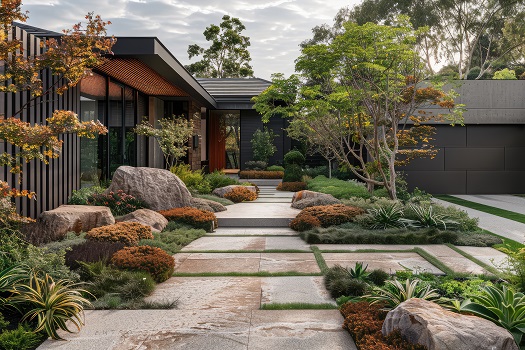The Best Strategy To Use For Hilton Head Landscapes
Hilton Head Landscapes Can Be Fun For Everyone
Table of ContentsThings about Hilton Head LandscapesSee This Report about Hilton Head LandscapesAbout Hilton Head LandscapesExcitement About Hilton Head LandscapesA Biased View of Hilton Head LandscapesThe 8-Minute Rule for Hilton Head LandscapesThe Main Principles Of Hilton Head Landscapes
Line produces all forms and patterns and can be made use of in a range of ways in the landscape. Line in the landscape is created by the side between 2 products, the synopsis or silhouette of a form, or a lengthy linear function. Lines are a powerful device for the designer due to the fact that they can be used to develop a limitless variety of shapes and types, and they manage movement of the eye and the body.

Lines can have one or more characteristics, such as those explained below, yet they generally offer different objectives. Figure 1. Lines in the landscape - Landscapers near me. The residential properties of lines figure out exactly how people react to the landscape, both psychologically and physically. Straight lines are architectural and forceful; they produce a formal personality, are usually connected with a balanced design, and lead the eye straight to a focal point.
Hilton Head Landscapes Fundamentals Explained
Rounded lines develop a casual, all-natural, kicked back personality that is connected much more with nature and asymmetrical equilibrium. Bent lines relocate the eye at a slower speed and add secret to the space by producing covert sights.
Upright lines in the landscape consist of high, narrow plant product, such as trees, or high frameworks, such as an arbor or a bird home on a pole. Straight lines move the eye along the ground airplane and can make an area feel larger. Reduced lines are a lot more controlled and produce a sensation of rest or repose.
The Best Strategy To Use For Hilton Head Landscapes
Low lines are developed by low yard walls, pathways, and brief hedges. Lines are made use of to draw kinds on a plan. In plan sight, they define plant beds and hardscape areas. Lines are likewise developed by the upright forms of built functions and plant material. There are 3 main line kinds that create kind in the landscape: bedlines, hardscape lines, and plant lines.
Bedlines connect plant product to your home and hardscape because the eye adheres to the line, moving the look through the landscape. Hardscape lines are developed by the side of the hardscape, which defines the constructed structure. Line can likewise be developed by lengthy and slim materials, such as a fence or wall.
Hilton Head Landscapes Fundamentals Explained
Kind is found in both hardscape and plants, and it is normally the leading aesthetic component that spatially arranges the landscape and typically identifies the design of the garden. The form of structures, plant beds, and yard ornaments likewise determines the general kind style of the garden. Formal, geometric forms include circles, squares, and polygons.
Plants create form in the garden through their describes or silhouettes, but form can additionally be defined by a space or negative area in between plants - landscape design hilton head (https://www.quora.com/profile/Steven-Gonzales-256). Circles can be cycles, or they can be separated right into half circles or circle segments and incorporated with lines to develop arcs and tangents
The 5-Minute Rule for Hilton Head Landscapes
Circles are a solid layout type because the eye is always attracted to the facility, which can be used to emphasize a focal factor or connect other types. Round types in hardscape and yard panels.
The square kind can also be fractional and used repetitively to produce a grid pattern. Unlike circles, squares are more powerful on the brink, which can be aligned or overlapped to create distinct patterns and more intricate forms. Polygons are many-sided types with straight sides. Triangles, for instance, are three-sided polygons.
Meandering lines often mimic the all-natural course of rivers or streams and can be referred to as smooth lines with deeply rounded wavinesses. Twisting lines (Figure 3) function well for pathways, plant bedlines, and dry stream beds. Meandering lines can add rate of interest and mystery to a garden by leading customers around corners to find brand-new sights and rooms.
Excitement About Hilton Head Landscapes

Figure 5. Fragmented edges: tipping stones in pathway. Kind is one of the most long-lasting quality of a plant (Landscapers near me). https://www.goodreads.com/user/show/179629915-steven-gonzales. Typical plant types are well developed and standard, as kind is the most regular and recognizable characteristic of plants. Kind can likewise be produced through the massing of plants, where the overall mass produces a different type than a specific plant.
A highly contrasting form should be made use of with careone or two job well as a prime focus, but also numerous develop mayhem. All-natural plant types, instead than over-trimmed types, ought to develop the bulk of the make-up. The importance of overall type is essentially depending on the viewing perspectivethe type of a tree can show up quite various to a person standing under the canopy versus watching the tree from a range in an open area.
What Does Hilton Head Landscapes Do?
Plant types additionally develop and specify deep space or open areas in between the plants, producing either convex or concave the original source kinds in deep spaces. High-arching tree branches normally develop a concave open room under the branches, and a round canopy with reduced branches fills the space to create a convex kind outdoors room under the tree.
